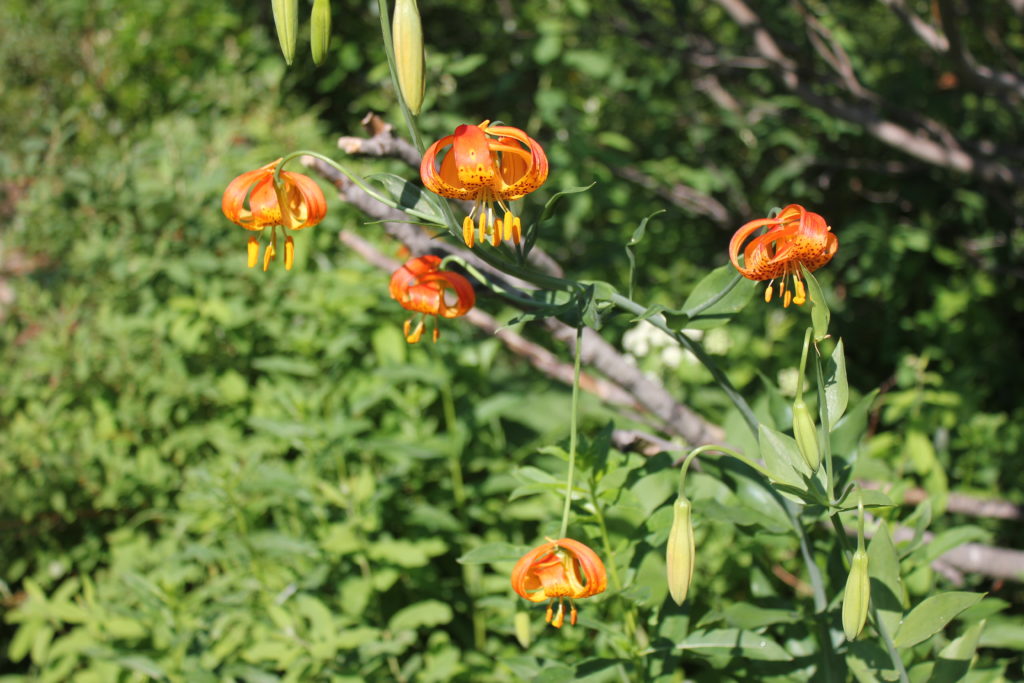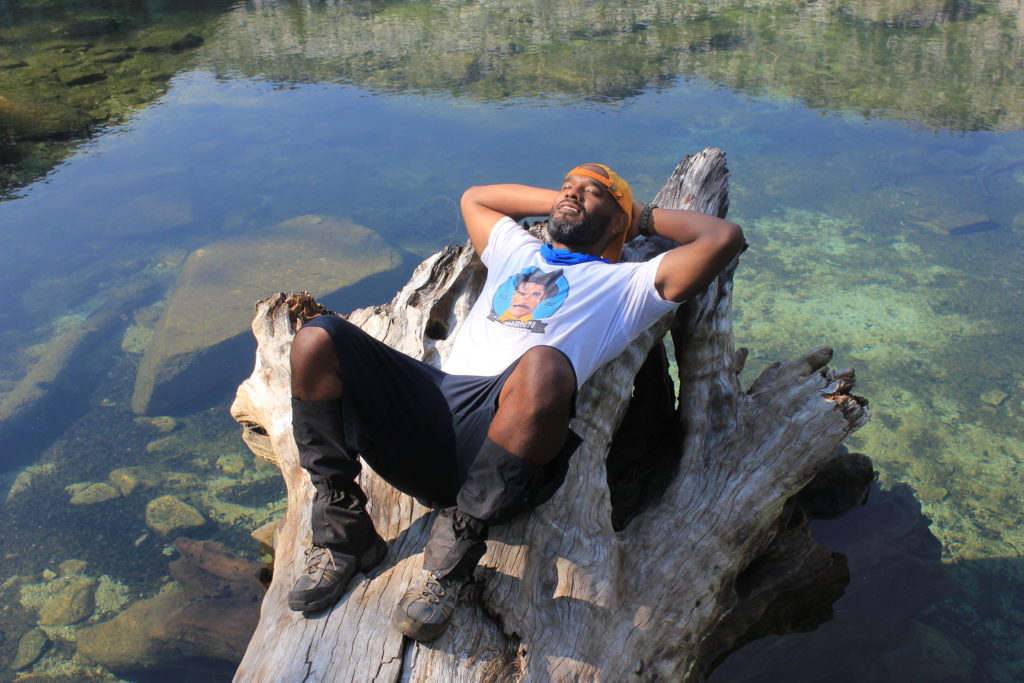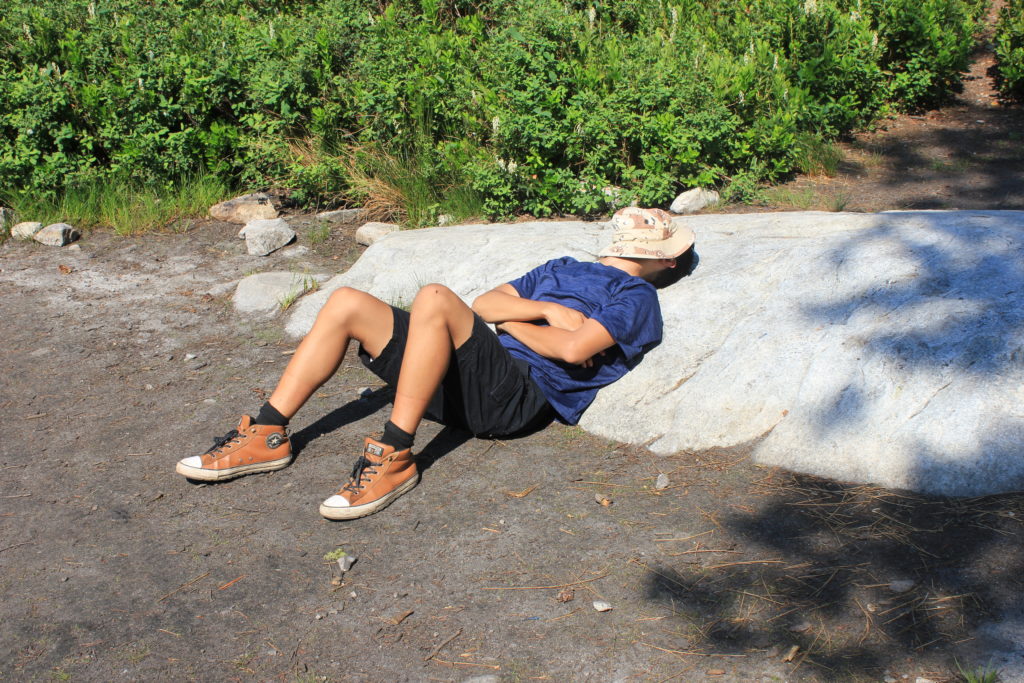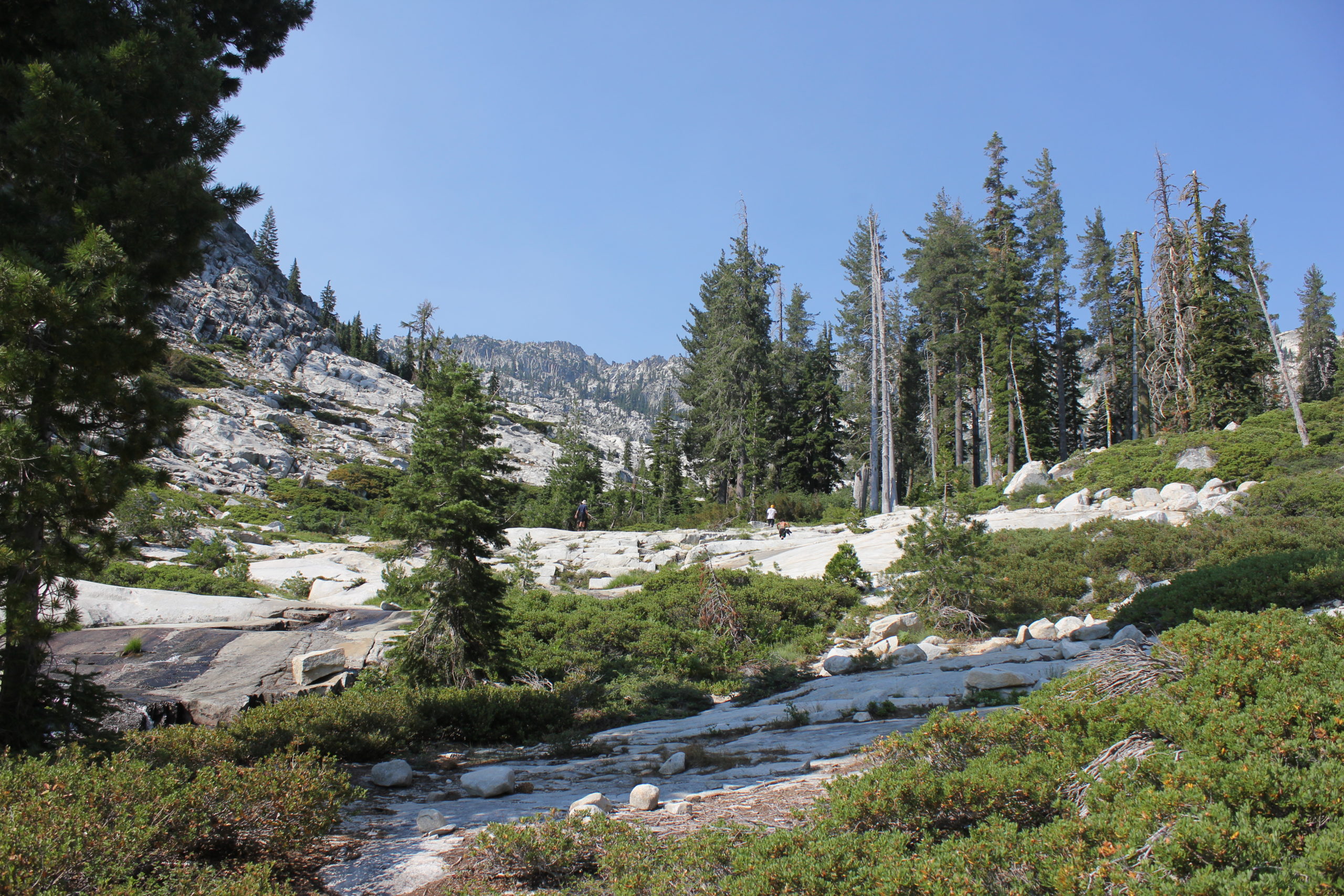— Martin Buber
It may seem odd to split a 3.5 mile hike into 2 days, but given the timing of when we arrived at the trailhead, the temperature, and the fact that for the youngsters it was their first time backpacking, it made a lot of sense. As usual, I was out of my tent as soon as I could see. Coffee followed shortly, and the aroma caused Dimari to stir and exit his tent. “How’s your back?” I asked, concerned about his first night on hard ground.
“You know, it’s pretty good!” he said brightly, and rousted the boys out of their sleeping bags. Dimari was eager to reach the lakes, and see the splendors of the trail ahead. He was no stranger to arduous excursions in the mountains. He and a friend had hiked all the way to the top of Mt. Shasta some years ago, and had also tried Mt. Sill – another “fourteener” – just last year, so he was used to acclimating to altitude and wrestling with gravity. He was a salesman by profession, which leveraged his natural gift for motivation and competition. Dimari was always up for a challenge, especially if there was a contest involved. “Let’s go, get up!” he clapped at the slowly moving lumps of nylon inside the 2-person tent. “Time to hit the trail!”
Sleepy heads emerged from their zippered cocoons, and soon the necessary chores of camping wiped away the cobwebs. Miles ate a reasonable facsimile of granola with powdered milk, while Jordan prepared a dubious omelet-in-a-bag. I stuck with my oatmeal and dried blueberries, while Dimari demolished a whole package of rice and beans for the carb load it provided. Not exactly a gourmet breakfast, but enough to fill our tanks for the most difficult parts of the trail ahead. Many hands made quick work of reassembling the backpacks for the next leg of our journey, and we were hitting the trail by the time the sun began filtering down to ground level.
The Magic Forest ended abruptly at a small set of stone steps leading to a fern-filled meadow, glowing neon green in the morning sunlight. Long shadows of the tall trees stretched across to where the trail seemed to disappear in the thick undergrowth. We pushed our way through, mindful of where we put our feet beneath the tangled ferns and scratchy bushes. Above us, the views opened up to reveal the granite outcrops beginning to invade a cerulean sky. There was no trace of the ominous smoke from yesterday, and we were all grateful to enjoy a sparkling clear, alpine morning surrounded by lush ferns and healthy trees. The trail began to get steep, and was littered once again with rolling stones, causing us to pay less attention to the view, and more on making our way through it.
“Watch where you put your feet, the trail’s not even,” I warned the boys.
“Yes, of course,” Jordan responded. He was at the age where he knew everything, but was pleasant enough to endure the unnecessary instructions. He pointed out a small blooming azalea next to the trail; the first ones we had seen. I stooped to smell the heavenly fragrance, but only a whiff was noticeable. They would be in full bloom a little bit later this year, I realized with disappointment. Still, there were plenty of tiger lilies to lift one’s spirits.

The views soon became more spectacular and varied, with purple shadows obscuring the faces of the Pharaohs to the south, and bright blades of granite piercing the skyline to the north. Our heads swiveled as searchlights across the panorama, despite the difficulties posed by shoulder straps that abused our necks. This, combined with the assortment of rocks, roots, bushes, fallen logs, and muddy springs along the trail, kept everyone busy and reduced conversation to a minimum. I pointed out the “quitting tree” that so unfairly holds a memory of unfulfillment for our family, and the boys were sad to think their Aunt Debbie never made it all the way to enjoy the beautiful lakes. Miles was holding up well, but was clearly exasperated by the grasping bushes, and the constant need to adjust his pack. Dimari came up from behind and secured a couple of his straps that were coming loose. The final mud-and-brush part of the trail was getting hot, and lazy swallowtails lounged on the numerous leopard lilies that shyly hung their heads in the swampy spots. All of a sudden, there it was! The bushes gave way, and a gently sloping expanse of white granite opened up before us, blazing in the sun. The outline of Mt. Shasta was barely visible through the smoke that still lingered from the Lava fire. We could hear Bear Creek singing through its pools and channels on the broad, sloping shelf of rock. A ragged cheer came to our lips, and trekking poles raised in mock triumph.
“Where do we have to go to get to Little Bear Lake?” That was Miles, ever the pragmatic realist. He didn’t have to be told that this was just a rest stop for us before the final and most difficult ascent. He listened well and remembered everything, and knew all the stages of the trail from my descriptions in the car. He just needed to match the labels in his mind with the scenery.
“Let’s drop our packs up here first, and take a look at Big Bear,” I suggested, and everyone experienced the sublime freedom of shedding a sweaty load, and floating like an untethered balloon. I left my pack in a spot where it would be easy to put back on, in the meager shade of a gnarled old root ball from an ancient, toppled tree. The drifting Epps Men meandered up towards the lake, following the shining, shimmering creek where it slid down slick slopes of granite, or twisted through cracks. In places it spread out warmly, as if uncertain which way to go. It got marshy up near the trees bordering the lake, so we crossed back to the bumpy, root-filled trail.
“Watch for snakes,” Miles announced dutifully. All the roots looked like snakes.
“Oh wow, it’s big!” exclaimed Jordan, the first to round the rocky bluff and see the expanse of Big Bear Lake. I could hear voices in the hidden campsite to our right, and I glimpsed a hiker and another tent up on the bluff to our left, but the largest (and most open) campsite was unoccupied. Slapping at the ubiquitous mosquitoes, we assembled on the flat rock-pier next to camp, where I had first seen the lake 48 years before. After a while, Dimari picked his way over to a big, wide fallen log that thrust out over the water, and laid down in its natural hammock. Jordan chose a sloping rock on which to recline, with his hat over his head in the sun. Miles poked around the shoreline for skipping stones (just as I had done at his age), and I played the impatient leader, hands on hips, thinking about the daunting Lego wall, and the best way to climb over it with packs. My old, gristly legs were holding up surprisingly well, thanks to my trusty knee braces and compression stockings, but I knew all too well the challenge of getting one’s gear up and over that jumble of granite ledges and grasping manzanita, and I glared at it the way a boxer sizes up an opponent.

“C’mon, we have to visit all 3 lakes in one day!” I announced to my lounging companions, who appeared to be getting too comfortable.
“Let’s do it!” exclaimed Dimari, and he bounced up from his perch on the log, nearly knocking over Miles, who was tossing stones at one of his water shoes that had fallen in the lake. Jordan revived agreeably and dusted off his shorts. One of the other campers came out of the bushes without any shoes on, gingerly walking away from the lake.
“Hey,” I waved in greeting, and he lurched his arm in reply.
“Nate, you forgot the wipes!” yelled one of his buddies from the hidden camp, and Nate was busted. Now everyone knew not only his name, but what he was doing, and he wasn’t happy about it! His ears were red as he disappeared behind some boulders. I made a mental note to avoid that corner of this frequently-camped area, the most popular destination on the Bear Lakes trail.
We traipsed down to the pools where we had left our backpacks, and reclaimed them from an army of quick little red ants that were trying to figure out how to stuff them into their nests. Miles flew into a rage, thrashing the would-be pilferers with a small stick; to no avail. I changed my shirt from the sweaty, trail-stained article to a fresh one that would soon be sweaty again. With our packs secured, we crossed the creek and angled up towards the dead tree that still stood as a marker to the best crossing. “Best” is a relative term, here, where balance is paramount, and one slip can topple a top-heavy hiker. I instructed the boys to always lean uphill, so if they lost their balance they would be much better off. Jordan lost no time finding his own brash route, which mostly involved going straight up and over everything. His bravado resulted in a dicey moment he revealed later, when he was flat on his belly with his pack on, searching blindly for a crevice or toehold. His chosen path took him far away and up, out of our sight. I wanted us to stay together for safety, but I understood the mindset of someone with the physical ability to traverse this terrain with alacrity, so I let him go. Dimari stayed close to Miles, helping him over the most precarious parts of the traverse, and just about the time we made it to the flat area by the dead tree, Jordan came down graciously to rejoin the party. A wee bit of bushwhacking (unavoidable at this juncture) put us across the barrier and on top of the massive granite shoulders of Dis Butte. From here, we could easily see our way up to the cleft that led to Wee Bear, still nearly a half mile away.

“Great job, Miles!” I knew that lots of encouragement was needed at his age, from past experiences with Kevin and Logan.
“Are there any more ‘hard parts’?” he peered at me through his curly bangs, which were dripping with sweat.
I had to be honest and answered, “Yes, there’s a big crack up ahead where you either have to go way uphill, or use your hands to cross it.”
“No problem, let’s go!” That was Dimari, ever the motivator with not an ounce of quit in him.
Jordan decided he’d better gain some altitude early to get around the big crevice. The rest of us followed the cairns that led to the familiar crossing I had used many times before. While the teenage mountain goat made quick work of his passage, Dimari and Miles paused at the edge.
“We have to cross that?” Dimari exclaimed, “What if we go down more?” he moved to find a better crossing, but I knew there wasn’t one.
“Why don’t you watch me cross here, so you can see what it’s like?” I offered, and moved across the sharp rocks with no problem, crab-walking to keep my pack from scraping the walls, and using my hands in a couple of places as insurance, in case anything beneath my feet moved. The drop was only about eight feet, unless one rolled down the entire rocky crevice, which would be unfortunate to say the least. Jordan came down to rejoin us after I crossed, and we rested in a place where we couldn’t see Dimari helping Miles through the worst bit… but we could sure hear it!
When I saw that pouty, curly-haired face rise above the bushes I shouted, “That’s it, you made it through the hardest part!!” He just glared at me.
We all rested for a while at this point. It was getting close to noon, with the sun at its apex, and no shade in sight. Miles was getting tired and cranky, but Jordan had all the vim and vigor of a young ram searching for territory, so he went off on his own again and gained more altitude, employing the same strategy to avoid the cleft leading from Wee Bear that I call “the portal.” The ample cairns led us down to a very sensible way of crossing the bushes, and soon we were safely on the other side, looking up at the access ramp to paradise. Huffing and puffing with the altitude, we climbed a dry waterfall to reach the opening.
Passing through the granite portal is like opening the back of the wardrobe into Narnia. The enchanted basin holding Wee Bear spreads out before the eyes like a living postcard, bathing one’s soul with a rewarding shower of beauty after a hot and tiresome struggle. Jordan wound up far above the little tarn, and impassable cliffs prevented him from descending, so I waved him on to meet us up at Little Bear. Dimari was the first to reach the shore, and he stopped to admire the view. Miles and I soon joined him, and my unbridled joy at seeing my grandchildren discover this holy place swept across the surface as a blissful wind.

“The wilderness holds answers to questions
we have not yet learned to ask.”
— Nancy Wynne Newhall

